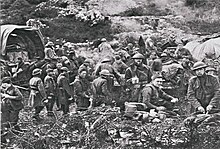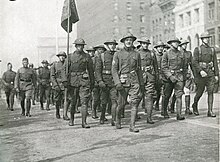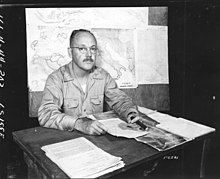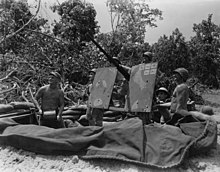|
37th Infantry Division (United States)
The 37th Infantry Division was a unit of the United States Army in World War I and World War II. It was a National Guard division from Ohio, nicknamed the "Buckeye Division". Today, its lineage is continued through the 37th Infantry Brigade Combat Team, with battalions from Ohio, Michigan, and South Carolina. World War I   It was initially activated as the 16th Division, a National Guard formation from Ohio and West Virginia in 1913. It was federally activated in August 1917 as a National Guard Division from Ohio. It was sent overseas in June 1918 and fought at the Meuse-Argonne and at Ypres-Lys offensives Order of battle
CasualtiesCommanders
Interwar periodThe 37th Division was reconstituted in the National Guard in 1921, allotted to the state of Ohio, and assigned to the V Corps. The 145th and 146th Infantry Regiments were consolidated and designated the 145th Infantry, while the 166th Infantry Regiment, which had been assigned to the 42nd Division in World War I, was assigned to the 37th Division. The 37th Division headquarters was federally recognized on 31 May 1923. The division trained most years at Camp Perry, Ohio, except for the 62nd Field Artillery Brigade, which often trained at Camp Knox (later Fort Knox), Kentucky, to utilize the artillery ranges located there. Newly-commissioned Organized Reserve lieutenants assigned to the Regular Army's 60th and 61st Infantry Regiments, which were maintained in an inactive status in the Fifth Corps Area, also trained with the division at Camp Perry. The division staff usually trained at Camp Perry, but participated in the Fifth Corps Area command post exercise (CPX) in 1929 and the Second Army CPX in 1938. In 1936, the division participated in the Fifth Corps Area phase of the Second Army maneuvers at Fort Knox. The entire division was called up for flood relief duty during the Ohio River Flood of 1937. In 1940, the division participated in the Second Army maneuvers near Camp McCoy, Wisconsin. The 37th Division was inducted into federal service at home stations on 15 October 1940 and moved to Camp Shelby, Mississippi. After the division’s basic training, it participated in the V Corps maneuver in June 1941, and in the GHQ maneuvers in August–September 1941.[1] Order of battle, 1939
Commanders
World War II
 Order of battleAfter the Division was activated in October 1940, it was originally to be commanded by Major General Glenson D. Light. However, Light failed to pass the new physical tests enacted on the guardsmen. To fill the vacancy, Ohio Governor John W. Bricker selected Robert Beightler, who he had known from his time as the chief engineer in Ohio's highway department.[2] The 112th Engineer Combat Battalion had been sent to Ireland in May 1942 as part of an advance party in anticipation of the 37th Infantry Division's deployment to Europe, but the division's orders were shortly changed to deployment to the Pacific Theater. The 29th Infantry Division's 121st Engineer Combat Battalion, less five officers and 120 men that remained with the division to form the nucleus of a new battalion, was assigned to the 37th Infantry Division as the new 117th Engineer Combat Battalion.
Combat chronicle The 37th Infantry Division arrived in Fiji in June 1942 to fortify the islands against possible invasion. The division continued its training on the islands. With the end of ground fighting on Guadalcanal, the division moved to that island in April 1943, continued training, and staged for the Munda campaign. Two battalions joined the Marine Raiders on New Georgia, 5 July 1943, while the remainder of the division landed, 22 July, and assisted the 43d Infantry Division in taking Munda airfield in heavy fighting. After mopping up on New Georgia, the division returned to Guadalcanal, 9 September 1943, for rest and rehabilitation.  The division's next assignment was Bougainville as part of the I Marine Amphibious Corps. Landing between 8 and 19 November 1943, the 37th Division expanded the western beachhead sector, constructed roads and bridges, and engaged in extensive patrol activity. On 15 December 1943, IMAC was relieved by the XIV Corps, to which the 37th Division was then assigned. In March 1944, two Japanese divisions made eight major attacks, but division lines held. In April patrols cleared the Laruma Valley area of major enemy units. The division remained on Bougainville and trained for the Luzon campaign. Landing with the Sixth Army on the beaches of Lingayen Gulf, 9 January 1945, the 37th raced inland against slight resistance to Clark Field and Fort Stotsenburg where fierce resistance delayed capture of those objectives until 31 January. The division continued to drive to Manila against small delaying forces, and entered the city's outskirts, 4 February. Upon crossing the Pasig River, it ran into bitter Japanese opposition.[3] By heavy street fighting, American and Filipino troops cleared the city by 3 March 1945. The Luzon campaign would prove the most costly for the division during the war, which earned them the nickname "Heavyweight".[4] After garrison duty in Manila, 5–26 March, the division shifted to the hills of Northwest Luzon, where heavy fighting culminated in the capture of Baguio, 26 April with aided Filipino troops under the 66th Infantry Regiment, Philippine Commonwealth Army, USAFIP-NL. Rest and rehabilitation during May were followed by action in June in the Cagayan Valley against deteriorating Japanese resistance. With the end of hostilities, 15 August, the division was concerned with the collection and processing of prisoners of war, leaving November 1945 for the States and demobilization. Major General Robert Beightler was one of only eleven generals who commanded their divisions for the entire war, and was the only National Guard general to do so.[5] Casualties
After 1945The division was reorganized in the Ohio Army National Guard in 1946. It served under federal control from 1952 to 1954 at Camp Polk, Louisiana. Although the division was not sent to Korea, nearly every soldier was as an individual replacement. The 37th went through a number of reorganizations from 1959 until it was disbanded on 15 February 1968. The bulk of the division's combat units became the 73rd Infantry Brigade, 38th Infantry Division with the remaining becoming the 16th Engineer Brigade and other combat support units. In 1977, the 73rd Brigade was released from assignment to the 38th ID and was redesignated the 73rd Infantry Brigade, a separate brigade. During the draw down of forces after the Cold War, units of the 73rd and the 107th Armored Cavalry Regiment consolidated to form the 37th Brigade, 28th Infantry Division. A year later, the brigade was reunited with the 38th Infantry Division. On 1 September 2007, 37th Infantry Brigade Combat Team (IBCT) was activated under the Army's modular plan. The shoulder sleeve insignia of the 37th IBCT is heavily based on that of the 37th Infantry Division and many units that are part of the 37th IBCT, served in the 37th Infantry Division. See also
ReferencesNotes
Sources
External linksWikimedia Commons has media related to 37th Infantry Division (United States). |
||||||||||||||||||||||||||||
